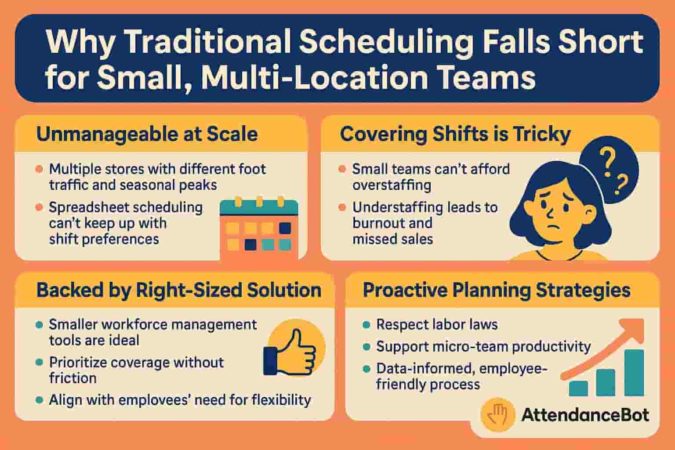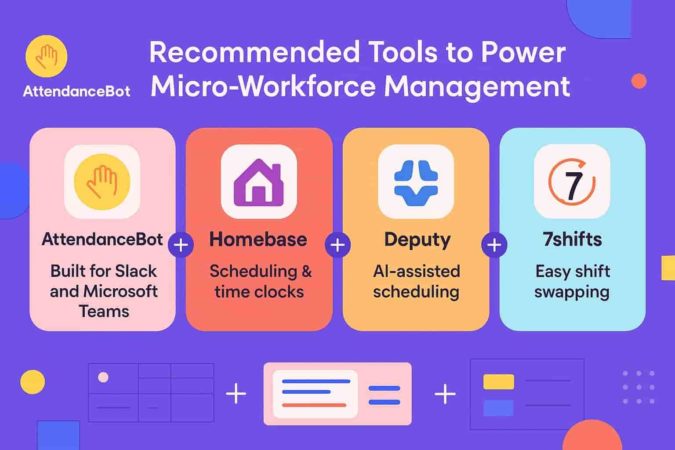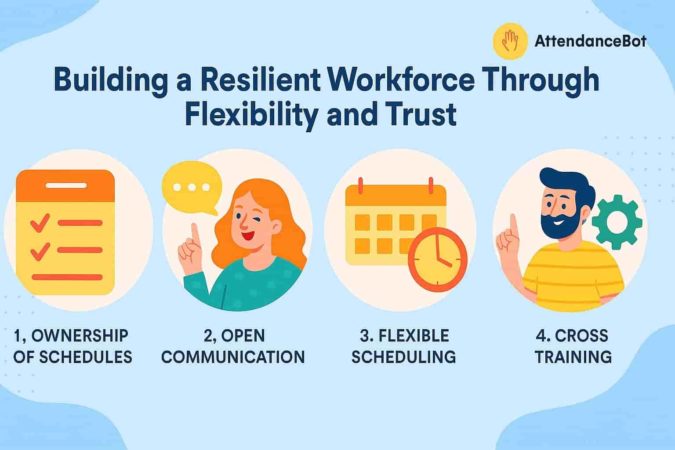Running workforce operations across multiple retail locations with small, lean teams is no easy task, especially when foot traffic fluctuates, employees want flexible hours, and labor laws don’t budge. For operations managers juggling store performance and employee satisfaction, the biggest challenge isn’t just getting coverage, it’s balancing workforce management for small teams in a way that’s both efficient and humane. While big retailers may have entire departments dedicated to workforce analytics, smaller teams need smarter, simpler systems that frontline managers and hourly staff can actually use. That’s where micro-team productivity strategies and modern scheduling tools come in. In this blog, we’ll explore how practical, scalable small business workforce planning approaches can help retail teams punch above their weight, improving coverage, reducing burnout, and delivering consistent customer service across every location.
Why Traditional Scheduling Falls Short for Small, Multi-Location Teams
Most retail operations managers know the drill: a color-coded spreadsheet, a flurry of last-minute texts, and a never-ending game of calendar Tetris. Traditional scheduling methods might work for one location with a small crew, but when you’re overseeing multiple stores, each with different foot traffic patterns, seasonal peaks, and employee shift preferences, it quickly becomes unmanageable.
Small teams can’t afford overstaffing, and understaffing means missed sales, employee burnout, or worse—poor customer experiences. And while big companies use advanced workforce management platforms, those tools often feel bloated or overly complex for smaller teams. What’s needed is a right-sized approach to workforce management for small teams—one that prioritizes coverage without creating friction or requiring a full-time admin to manage.
For many operations managers, the challenge isn’t just filling shifts, it’s doing it in a way that respects labor laws, supports micro-team productivity, and aligns with employees’ need for flexibility. The good news? With the right strategies and tech, small business workforce planning doesn’t have to be reactive or chaotic. It can be proactive, data-informed, and employee-friendly.

The Micro-Enterprise Mindset: Treat Each Store Like Its Own Agile Team
What if each of your retail locations operated more like a startup than a satellite? That’s the core of the micro-enterprise mindset, a workforce management strategy that gives individual store teams more autonomy in scheduling while staying aligned with company-wide standards.
Instead of top-down scheduling, empower each store manager to co-create the weekly schedule with their staff. Combine on-the-ground insights (like who thrives during peak hours) with centralized guidelines (like labor compliance and coverage thresholds). This hybrid approach helps boost micro-team productivity and turns scheduling into a team-driven process, not a one-person pain point.
To make this work, adopt tools that let employees submit availability, swap shifts, and request time off, without requiring manual updates from headquarters. Think mobile-first, real-time, and intuitive. That way, small business workforce planning becomes a collaborative effort, not a burden passed down the chain.
The result? Better engagement, fewer no-shows, and a stronger sense of ownership at the store level—all while you maintain visibility and control across locations.
Real-World Example: How a Regional Retail Chain Made Scheduling Smarter and More Flexible
Consider a regional fashion retail brand with 12 stores spread across suburban malls and downtown shopping districts. Each location faced unique staffing challenges – weekend surges in the suburbs, lunchtime rushes downtown, and an ever-growing list of employee availability constraints.
The operations manager implemented a workforce management platform designed specifically for workforce management for small teams, one that allowed for mobile availability input, smart shift suggestions based on peak footfall, and instant alerts for coverage gaps. They introduced the micro-enterprise mindset by giving store managers access to analytics dashboards showing when their busiest hours occurred and which employees performed best during those times.
Instead of scheduling based on tenure or favoritism, they used real-time data to match shift needs with employee strengths and preferences. Employees felt more in control of their schedules, which boosted morale and reduced last-minute call-outs by 37%. Managers, on the other hand, reclaimed hours each week previously spent juggling spreadsheets and texts.
And most importantly, customer satisfaction scores went up. With stronger coverage and happier staff, each store began performing like a well-oiled micro-business, with better outcomes and fewer fires to put out.
Recommended Tools to Power Micro-Workforce Management
For operations managers juggling multiple store schedules, the right tools can be the difference between chaos and control. But don’t mistake complexity for capability—small business workforce planning needs lightweight, scalable tools that are easy to adopt across frontline teams.
Here are a few solutions designed with micro-team productivity in mind:
- AttendanceBot – Built for Slack and Microsoft Teams, this tool makes it simple to manage availability, assign shifts, and track time off without switching platforms. Perfect for teams that already live in chat.
- Homebase – A great option for small retail teams, offering scheduling, time clocks, and basic labor law compliance features in one place.
- Deputy – Ideal for operations managers who want AI-assisted scheduling based on foot traffic patterns, sales trends, or custom rules.
- 7shifts – While built for restaurants, many multi-location teams use this for its easy shift swapping, mobile-first interface, and forecasting tools.
Look for tools that:
- Integrate with your existing systems (e.g., POS, payroll)
- Offer self-service features for employees (availability input, shift swaps)
- Are easy for store managers to pick up without formal training
Pro tip: Choose platforms that provide usage data and compliance insights. These dashboards help spot issues—like understaffing during peak hours or excessive overtime, before they become problems.

Overcoming Common Scheduling Pitfalls
Scheduling for a small team or micro-workforce can come with its own unique set of challenges, especially when trying to balance business needs, compliance, and employee satisfaction. Here are some common scheduling pitfalls HR professionals should look out for, and practical ways to avoid them:
1. Overstaffing During Low Activity Periods
It’s tempting to stick to a standard schedule without considering fluctuations in team or business needs. Overstaffing can lead to wasted resources and unnecessary operational costs.
Solution: Use data-driven scheduling tools that integrate sales data, workload forecasts, or activity metrics. By analyzing historical data, tools like Deputy and 7shifts help predict when your team will be needed the most, allowing you to schedule efficiently and avoid overstaffing during off-peak times.
2. Understaffing During High-Demand Periods
While overstaffing is a concern, understaffing can be equally detrimental, especially during critical times. Whether it’s a busy project, seasonal peak, or an unexpected spike in workload, underestimating the need for staff can lead to lower productivity and employee burnout.
Solution: Implement dynamic scheduling tools that forecast demand based on both internal and external factors, such as employee availability, project deadlines, or seasonal trends. AttendanceBot and Homebase offer real-time scheduling capabilities that adapt to fluctuations in demand, ensuring that your team is always appropriately staffed.
3. Neglecting Employee Preferences and Availability
With employees becoming more vocal about their work preferences, failing to account for their availability can result in dissatisfaction, absenteeism, or turnover.
Solution: Integrate employee-driven scheduling into your system. Modern platforms like Deputy allow employees to input their availability, submit time-off requests, and even swap shifts easily. This reduces scheduling conflicts and gives employees more autonomy, improving their job satisfaction.
4. Ignoring Labor Law Compliance and Overtime Rules
As an HR professional, ensuring compliance with labor laws and preventing overtime violations is a must. Manual tracking can often lead to costly mistakes and legal issues.
Solution: Invest in automated workforce management software that has built-in compliance tools. Many platforms, including Deputy and AttendanceBot, automatically calculate overtime, break times, and help reduce compliance risks by allowing teams to set automated overtime rules, including presets based on U.S. state labor laws.
Building a Resilient Workforce Through Flexibility and Trust
To ensure employee satisfaction, reduce turnover, and improve workforce productivity, HR professionals must create a resilient workforce. Achieving this requires offering flexibility without compromising business needs. Here are some strategies to build a more adaptable and engaged team:
1. Give Employees Ownership of Their Schedules
Employees today expect more control over their work-life balance. Allowing team members to input their availability and preferences helps them feel valued and heard.
Solution: Enable employees to take charge of their schedules through self-service scheduling systems like Homebase or AttendanceBot. These tools allow employees to manage their time off requests, swap shifts, and adjust their availability, leading to fewer conflicts and a more harmonious workplace.
2. Foster a Culture of Open Communication
Transparency and communication go hand in hand when building trust with your team. Open channels of communication about schedules, shift changes, and workload can help prevent misunderstandings and create a more cohesive work environment.
Solution: Use collaboration tools like Slack, integrated with AttendanceBot, to communicate shift changes, scheduling updates, and other important announcements in real-time. This ensures that employees are always in the loop and can make adjustments when necessary.
3. Offer Flexibility Without Sacrificing Coverage
Balancing employee flexibility and adequate staffing coverage is especially challenging during high-demand periods. However, flexibility doesn’t have to mean leaving the business unprotected.
Solution: Use AI-powered forecasting and dynamic scheduling tools to create flexible schedules that meet business needs while also respecting employee preferences. Platforms like Deputy allow HR managers to predict when staffing will be needed and build schedules that can easily adapt to changing circumstances, such as holidays or seasonal surges.
4. Encourage Cross-Training for a More Agile Workforce
A resilient workforce is adaptable. Cross-training employees in multiple roles within the organization helps reduce scheduling conflicts and ensures that operations can continue smoothly even during peak times or when employees are unavailable.
Solution: Use your workforce management tools to track employee skills and certifications, so you can quickly identify who can step in to fill different roles during busy periods. Platforms like Deputy and AttendanceBot help managers schedule shifts based on skills, making it easier to deploy the right person for the job when needed.

Leveraging Technology for Smarter Workforce Management
In a rapidly changing work environment, technology plays a critical role in optimizing workforce management. For small teams and micro-workforces, the right technology solutions can make a significant impact by streamlining processes, improving communication, and driving productivity without overwhelming the team.
1. Automating Routine Tasks
Manual scheduling is not only time-consuming but can also introduce errors that affect team productivity. By automating routine tasks such as shift scheduling, time-off requests, and managing overtime, HR professionals can save time and reduce the chance of mistakes.
2. Integration with Other Business Systems
For seamless operations, integrating workforce management systems with other essential business tools—like payroll, performance tracking, or project management platforms—can streamline processes and provide a unified view of operations.
3. Harnessing Data and Analytics
Small teams can still benefit from data-driven decision-making. By tracking key performance indicators, scheduling trends, and labor costs, HR managers can optimize staffing levels, anticipate demand, and adjust schedules accordingly. Data also helps identify gaps in productivity and provides insights into employee engagement.
4. Fostering Employee Engagement with Easy-to-Use Platforms
An intuitive, user-friendly system enhances the employee experience, making it easy for them to manage their schedules, request time off, and stay connected with the team. This level of transparency and autonomy helps reduce confusion and increases employee satisfaction, ultimately improving retention rates.
Conclusion: Mastering Workforce Management for Small Teams
Effective workforce management is essential for small teams looking to stay competitive. It’s about finding a balance between business needs and employee preferences while leveraging the right strategies and technology to support growth. By embracing automated scheduling, integrating key business functions, and focusing on employee engagement, even the smallest teams can maximize efficiency and build a resilient, productive workforce.
As organizations continue to evolve, it’s crucial to implement strategies that prioritize flexibility, data-driven decisions, and seamless communication. With the right approach, small teams can not only meet but exceed the demands of today’s business landscape, fostering an environment that benefits both employees and the organization as a whole.



